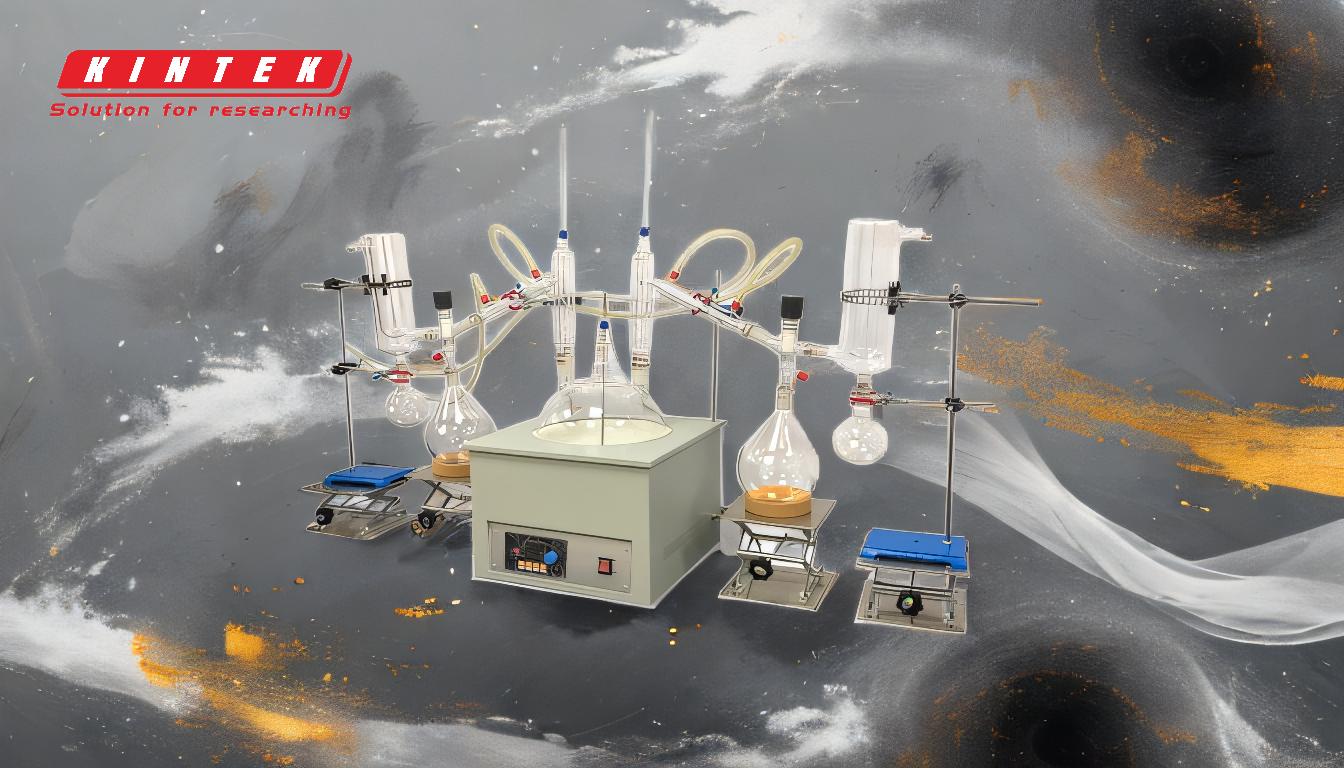To perform simple distillation, you need a basic setup that includes a heat source, a distillation flask, a condenser, and a receiving flask. The process involves heating a liquid mixture in the distillation flask until it boils, causing the more volatile component to vaporize. The vapor then travels through the condenser, where it is cooled and condensed back into a liquid, which is collected in the receiving flask. This method is ideal for separating liquids with significantly different boiling points. The equipment required is relatively simple and does not involve complex components like vacuum pumps or fractionating columns, which are used in more advanced distillation techniques such as fractional or vacuum distillation.
Key Points Explained:

-
Heat Source:
- Purpose: Provides the energy needed to heat the liquid mixture in the distillation flask to its boiling point.
- Options: Common heat sources include a hot plate, heating mantle, or even a Bunsen burner. The choice depends on the boiling point of the liquid and the scale of the distillation.
- Considerations: The heat source should be adjustable to control the rate of heating and prevent overheating, which could lead to decomposition of the liquid or uneven boiling.
-
Distillation Flask:
- Purpose: Holds the liquid mixture to be distilled. As the liquid is heated, the more volatile component vaporizes.
- Design: Typically a round-bottom flask, which allows for even heating and minimizes the risk of bumping (sudden, violent boiling).
- Capacity: The size of the flask should be appropriate for the volume of the liquid mixture to avoid spillage or excessive headspace.
-
Condenser:
- Purpose: Cools the vaporized component, causing it to condense back into a liquid.
- Types: The most common type is a Liebig condenser, which consists of a straight tube surrounded by a water jacket. Water flows through the jacket to cool the vapor.
- Cooling Medium: Water is the most common cooling medium, but other coolants like ice or refrigerated liquids may be used for substances with very low boiling points.
- Positioning: The condenser is typically placed at an angle to allow the condensed liquid to flow smoothly into the receiving flask.
-
Receiving Flask:
- Purpose: Collects the condensed liquid (distillate) after it passes through the condenser.
- Design: Usually a round-bottom or Erlenmeyer flask, which is easy to handle and can be sealed if necessary.
- Capacity: Should be large enough to hold the expected volume of distillate, with some extra space to prevent overflow.
-
Thermometer (Optional but Recommended):
- Purpose: Monitors the temperature of the vapor as it enters the condenser, helping to ensure that the distillation is proceeding as expected.
- Placement: The thermometer is typically placed in the distillation head, just above the distillation flask, to measure the temperature of the rising vapor.
- Accuracy: A high-precision thermometer is important for accurately determining the boiling point of the distillate.
-
Support Stand and Clamps:
- Purpose: Holds the distillation flask, condenser, and receiving flask in place, ensuring stability during the distillation process.
- Materials: Typically made of metal, with adjustable clamps to securely hold the glassware.
- Safety: Proper clamping is essential to prevent accidents, such as the flask tipping over or the condenser slipping out of place.
-
Sealing and Connections:
- Purpose: Ensures that the system is airtight, preventing the escape of vapors and maintaining the integrity of the distillation process.
- Materials: Ground glass joints or rubber stoppers are commonly used to connect the distillation flask, condenser, and receiving flask.
- Leak Prevention: Properly sealing all connections is crucial to avoid leaks, which could lead to loss of product or contamination.
-
Safety Equipment:
- Purpose: Protects the user from potential hazards such as hot surfaces, chemical spills, or toxic vapors.
- Examples: Heat-resistant gloves, safety goggles, and a lab coat are essential. A fume hood may be necessary if working with volatile or toxic substances.
- Emergency Preparedness: Have a fire extinguisher and first aid kit readily available in case of accidents.
In summary, simple distillation requires a straightforward setup consisting of a heat source, distillation flask, condenser, and receiving flask. Additional components like a thermometer, support stand, and safety equipment enhance the efficiency and safety of the process. This method is particularly useful for separating liquids with distinct boiling points and is a fundamental technique in both laboratory and industrial settings.
Summary Table:
| Component | Purpose | Key Considerations |
|---|---|---|
| Heat Source | Provides energy to heat the liquid mixture to its boiling point. | Adjustable heat control; options include hot plates, heating mantles, or Bunsen burners. |
| Distillation Flask | Holds the liquid mixture; vaporizes the more volatile component. | Round-bottom design for even heating; appropriate size to avoid spillage. |
| Condenser | Cools vaporized components, condensing them back into liquid. | Liebig condenser with water cooling; angled for smooth liquid flow. |
| Receiving Flask | Collects the condensed liquid (distillate). | Round-bottom or Erlenmeyer flask; sufficient capacity to prevent overflow. |
| Thermometer | Monitors vapor temperature for accurate boiling point determination. | High-precision; placed in the distillation head. |
| Support Stand | Holds glassware securely in place. | Adjustable clamps for stability; made of metal for durability. |
| Sealing & Connections | Ensures an airtight system to prevent vapor escape. | Ground glass joints or rubber stoppers; proper sealing to avoid leaks. |
| Safety Equipment | Protects users from hazards like hot surfaces, spills, or toxic vapors. | Includes gloves, goggles, lab coat, and fume hood if necessary. |
Ready to set up your distillation process? Contact our experts today for personalized guidance and equipment recommendations!










